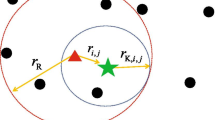Abstract
In this paper, we consider non-orthogonal multiple access (NOMA) for wireless ad hoc networks over block fading channels where the performance is limited by interference and fading. In order to provide a reasonable performance, we can use re-transmission and interference cancellation techniques. Re-transmission techniques can provide a diversity gain over fading channels, while the successive interference cancellation (SIC) can improve the signal to interference ratio (SIR). Using the information outage probability, we show that the NOMA approach with re-transmissions can perform better than the orthogonal multiple access (OMA) approach with re-transmissions when the signal to noise ratio (SNR) is low. It is also shown that the outage probability of the NOMA with SIC is lower than that of OMA when the rate is sufficiently low where SIC can be facilitated.
Similar content being viewed by others
References
IEEE 802.11 Working Group. (1999). Wireless LAN medium access control (MAC) and physical layer (PHY) specification.
Muqattash, A., & Krunz, M. (2003). CDMA-based MAC protocol for wireless ad hoc networks. In Proceedings of MobiHoc’03 (pp. 153–164).
Al-Meshhadany, T., & Ajib, W. (2007). New CDMA-based MAC protocol for ad hoc networks. In: Proceedings of IEEE VTC Fall 2007 (pp. 91–95).
Cover T. M., Thomas J. A. (1991) Elements of information theory. Wiley, New York
Gallager R. G. (1994) An inequality on the capacity region of multiple access multipath channels. In: Blahut R. E., Costello D. J., Maurer U., Mittelholzer T. (eds) Communications and cryptography: Two sides and one tapestry. Kluwer, Boston, pp 129–139
Shamai S., Verdu S. (2001) The impact of frequency-flat fading on the spectral efficiency of CDMA. IEEE Transactions on Information Theory 47: 1302–1327
Guess T., Varanasi M. K. (2005) An information-theoretic framework for deriving canonical decision-feedback receivers in Gaussian channels. IEEE Trans. Inform. Theory 51: 173–187
Forney, G. D., Jr. (2004). Shannon meets Wiener II: On MMSE estimation in successive decoding schemes. In: Proceedings of the 42nd annual allerton conference communication, control, and computing. Monticello.
Tse D., Viswanath P. (2005) Fundamentals of wireless communication. Cambridge University Press, Cambridge
Caire G., Tunietti D., Verdu S. (2004) Suboptimality of TDMA in the low-power regime. IEEE Transactions on Information Theory 50: 608–620
Verdu S. (2002) Spectral efficiency in the wide-band regime. IEEE Transactions on Information Theory 48: 1319–1343
Caire G., Guemghar S., Roumy A., Verdu S. (2004) Maximizing the spectral efficiency of coded CDMA under successive decoding. IEEE Transactions on Information Theory 50: 152–164
Li K., Wang X., Ping L. (2007) Analysis and optimization of interleave-division multiple-access communication systems. IEEE Transactions on Wireless Communications 6: 1973–1983
Lin S., Costello D. (2004) Error control coding, 2nd ed. Prentice Hall, Englewood Cliffs
Wicker S. B. (1995) Error control systems for digital communication and storage. Prentice Hall, Englewood Cliffs
Hou F., She J., Ho P.-H., Shen X. (2010) Performance analysis of the cumulative ARQ in IEEE 802.16 networks. Wireless Networks 16: 559–572
Caire G., Tunietti D. (2001) The throughput of hybrid-ARQ protocols for the Gaussian collision channel. IEEE Transactions on Information Theory 47: 1971–1988
Tunietti D., Caire G. (2002) The throughput of some wireless multiaccess systems. IEEE Transactions on Information Theory 48: 2773–2785
Hagenauer J. (1988) Rate-compatible punctured convolutional codes (RCPC codes) and their applications. IEEE Transactions on Communications 36: 389–400
Ha J., Kim J., McLaughlin S. W. (2004) Rate-compatible puncturing of low-density parity-check codes. IEEE Transactions on Information Theory 50: 2824–2836
Cheng, J.-F. (2010). Coding performance of HARQ with BICM Part I: Unified performance analysis. In: Proceedings of IEEE PIMRC (pp. 976–981)
Biglieri E., Proakis J., Shamai S. (1998) Fading channels: Information-theoretic and communication aspects. IEEE Transactions on Information Theory 44: 2619–2692
Ozarow L., Shamai S., Wyner A. D. (1994) Information theoretic considerations for cellular mobile radio. IEEE Transactions on Vehicular Technology 43: 359–378
Viswanath P., Tse D. N. C., Laroia R. (2002) Opportunistic beamforming using dumb antennas. IEEE Transactions on Information Theory 48: 1277–1294
Shen C., Liu T., Fitz M. P. (2009) On the average rate performance of hybrid-ARQ in quasi-static fading channels. IEEE Transactions on Communications 57: 3339–3352
Sesia S., Caire G., Vivier G. (2004) Incremental redundancy hybrid ARQ schemes based on low-density parity-check codes. IEEE Transactions on Communications 52: 1311–1321
Wu P., Jindal N. (2010) Performance of hybrid-ARQ in block-fading channels: A fixed outage probability. IEEE Transactions on Communications 58: 1129–1141
Makki B., Eriksson T. (2010) On the average rate of quasi-static fading channels with ARQ and CSI feedback. IEEE Communications Letters 14: 806–808
Boyd S., Vandenberghe L. (2004) Convex optimization. Cambridge University Press, Cambridge
David H. A. (1981) Order statistics, 2nd ed. Wiley-Interscience, New York
Author information
Authors and Affiliations
Corresponding author
Rights and permissions
About this article
Cite this article
Choi, J. On Multiple Access Using H-ARQ with SIC Techniques for Wireless Ad Hoc Networks. Wireless Pers Commun 69, 187–212 (2013). https://doi.org/10.1007/s11277-012-0568-8
Published:
Issue Date:
DOI: https://doi.org/10.1007/s11277-012-0568-8




